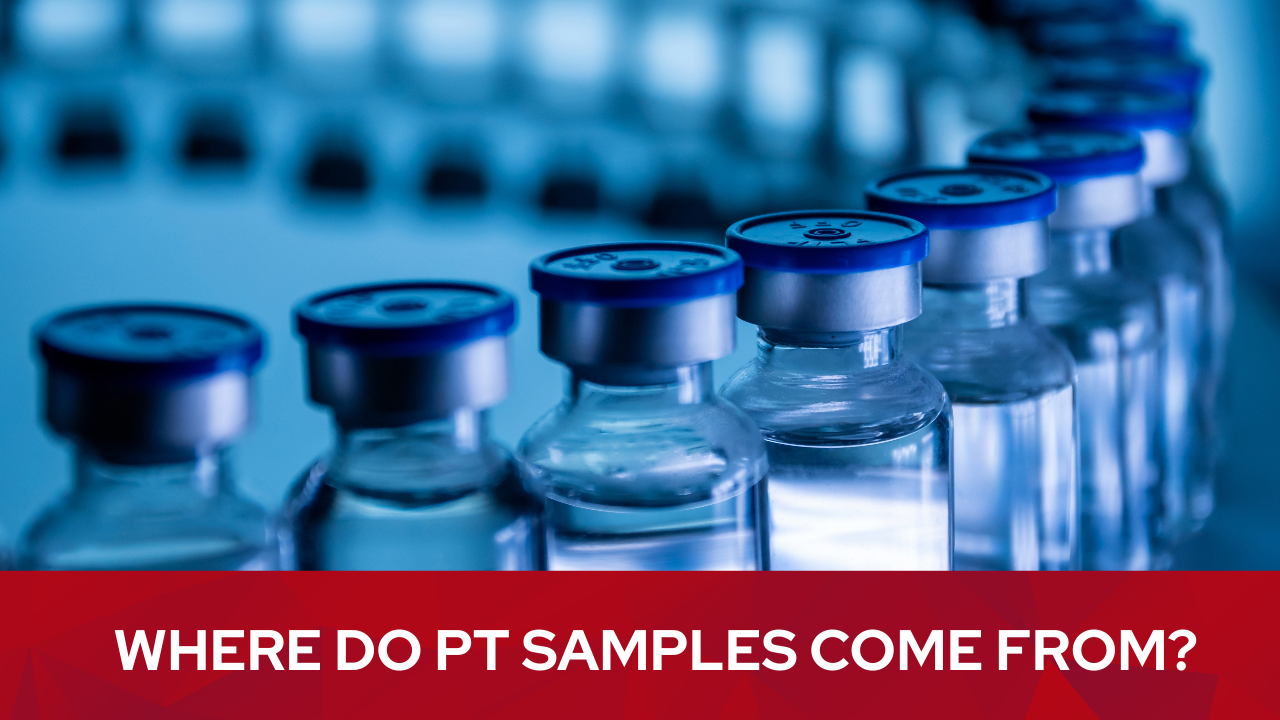The Journey of Proficiency Testing Samples: Sourcing, Creation, and Quality Assurance
Proficiency testing plays a crucial role in ensuring the quality and accuracy of diagnostic testing. It helps healthcare providers identify areas for improvement, maintain compliance with regulatory standards, and ultimately enhance patient care. Central to the proficiency testing process are the samples used for evaluation; but, have you ever wondered where these proficiency testing (PT) samples come from?
In this article, we will discuss how PT samples are sourced by CMS-approved, clinical PT providers under the Clinical Laboratory Improvement Amendments (CLIA). Knowing how PT samples are created, procured, and distributed sheds more light on sample handling, storage, and their overall role in maintaining quality control standards.

Understanding Proficiency Testing Samples
Proficiency testing samples, also known as PT samples, are intricately designed materials that closely resemble patient specimens. These samples cover an extensive array of medical tests, spanning specialties like chemistry, hematology, microbiology, and immunology. Specialized commercial vendors play a pivotal role in manufacturing and distributing these PT samples to clinical laboratories globally. These vendors house teams of experts dedicated to creating and packaging PT samples that accurately simulate real patient specimens.
Partnership between CMS-Approved PT Providers and Commercial Vendors
CMS-approved proficiency testing providers collaborate with commercial manufacturers to acquire the necessary samples for assessing clinical laboratories enrolled in PT programs. Since the inception of ISO standards in 1987 and the Clinical Laboratory Improvement Amendments (CLIA) of 1988, these providers have worked diligently to ensure the procurement of high-quality PT materials. They draw upon a network of national and international commercial vendors to source samples essential for their PT programs.
Manufacturing Proficiency Testing Samples
Proficiency testing samples predominantly comprise synthetic materials. However, some samples may incorporate human or animal-derived materials like blood components, urine, serum, plasma, or other biological fluids. The choice of materials hinges on the specific tests being simulated. Raw materials undergo processing and formulation to mimic the properties of real patient specimens. This involves adjusting concentrations, incorporating preservatives, stabilizing agents, and ensuring the samples possess the appropriate characteristics to closely resemble human serum.
Reference labs, often associated with academic institutions or research centers, collaborate to maintain the quality of proficiency testing samples. For instance, the WSLH Proficiency Testing sources samples from manufacturers, but their Blood Lead program uniquely produces samples in-house.
The Unique Process of Blood Lead PT Program
At the Wisconsin State Laboratory of Hygiene (WSLH), the Blood Lead PT program stands as a remarkable example of in-house sample production. Four Jersey cows reside at the Dairy Forage Research Center at the University of Wisconsin-Madison for their sole participation in our Blood Lead PT program. These cows are dosed with lead twice a year to produce units for sample development. Before the program’s commencement over a decade ago, a study validated that dosing cows with lead twice a year didn’t affect their quality of life. Karyn Blake, the Materials Program Administrator at WSLH’s Chemical Emergency Response Program, details the unique use of bovine blood in producing PT samples for lead, mercury, and cadmium analyses. This approach is crucial due to the challenges and scarcity of using human blood for sample production.

Stock photo of Jersey cows, courtesy of Adobe Stock
Once the lead doses are administered to the cows, the collected bovine blood is processed, screened for endogenous lead concentrations, frozen into units, and stored for use in PT programs. These units can be tailored to specific concentrations as requested by different laboratories participating in proficiency testing. The blood samples may vary depending on the laboratory’s testing needs, tailored either for Point-of-Care testing or spiked with higher concentrations of lead for proficiency testing via more complex methods. For the multi-element panel PT program, the units are spiked for mercury and cadmium analysis.
Karyn Blake emphasizes the impact of this process on maintaining labs’ accreditation needs and ensuring the precision and reliability of clinical testing across various facilities. This innovative approach showcases a unique method of creating PT samples for crucial analyses. To review WSLH PT’s Blood Lead program, view page 11 in our 2024 Clinical PT Product Catalog.
Ensuring Sample Quality
During the creation of PT samples, rigorous quality control measures are implemented by commercial vendors and reference laboratories. Manufacturers of PT samples verify their accuracy, precision, and stability over time. Proficiency Testing providers, when selecting vendors to supply samples for their programs will review evidence of manufacturing quality and certificates of conformance to the ISO 9001:2015 standard for manufacturers of custom proficiency and EQA products. Once formulated and validated, PT samples are meticulously packaged to preserve their integrity during transportation and storage.
Conclusion: The Essence of Proficiency Testing Samples
The journey of proficiency testing samples, from conception to evaluation, is a meticulously orchestrated process. Commercial vendors and reference laboratories, armed with expert knowledge and an unwavering commitment to quality, collaborate with CMS-approved proficiency testing providers. This collaboration ensures the availability of high-caliber PT materials. These meticulously crafted samples, designed to emulate real patient specimens, stand as a critical component in the development of quality proficiency testing programs.
CMS-approved proficiency testing providers play a pivotal role in acquiring, distributing, and evaluating these samples for the development of PT programs. Their dedication ensures that healthcare facilities uphold high standards of quality and accuracy in patient care. As the diagnostic landscape in healthcare evolves, WSLH Proficiency Testing remains dedicated to advancing its mission of innovation, quality, and safety in clinical laboratory improvement.
In conclusion, the sourcing, creation, and quality assurance of proficiency testing samples are fundamental in upholding the integrity and precision of diagnostic testing. The intricate process and dedication behind these samples play a crucial role in advancing healthcare standards and the accuracy of patient care.

